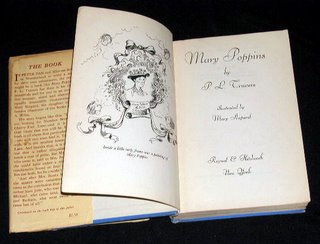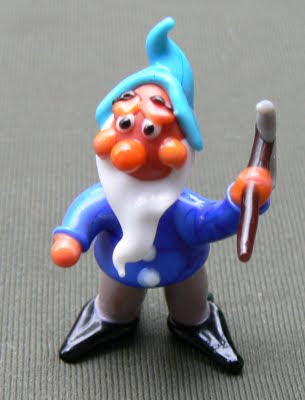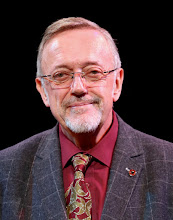
I was going to tea with Mary Poppins!
Well, no, not
exactly, but I
was going to tea with P L Travers, who had written the
Mary Poppins books and, at that precise moment, I was walking down a street of neat-and-tidy-looking houses that reminded me very much of Cherry Tree Lane…
True, Shawfield Street - off the King’s Road in London’s Chelsea – didn’t boast any really grand houses (with two gates) like that owned by Miss Lark and none of them were quite as unusual or as exciting as the ship-shape home of Admiral Boom… But, as I arrived at the door of number 29, I felt as if I might expect to find Robertson Ay asleep on the doorstep or hear the argumentative voices of Mrs Brill and Ellen coming up from the basement…
This all happened twenty-four years ago, but I remember it now as vividly as if it had only happened yesterday…
I’d been invited to come to tea at four o’clock and I was a little early –
ten minutes early to be precise – because I really didn’t want to be late and keep Mary Poppins waiting...
I went up the steps to the front door – which, rather surprisingly, was painted candyfloss pink – and I rang the bell.
Silence.
I rang again.
Still silence.
Had I got the wrong day, I wondered.
Then a window, two storeys up, flew open and a head popped out and asked, in a brisk tone, “Are you Brian Sibley?”
I said that I was.
“Well,” said the head, “you are early!” And the window rattled shut again.
I waited. And I waited. For the full ten minutes I waited - until the clock on a nearby church struck ‘four’. Only then did a woman with curly grey hair and bright forget-me-not blue eyes open the door.

So, this was P (for Pamela) L (for Lyndon) Travers…
I noticed that she was wearing a pair of ‘sensible shoes’ of the kind Mary Poppins wore; but, in contrast, she sported a very
un-Poppinsish dress with lots of frills and flounces, a number of jingly-jangly bracelets and bangles (rather like those favoured by Miss Lark, I thought) and a chunky turquoise necklace.
After my wait on the doorstep, I was a little nervous, but she welcomed me in with a smile, threw my coat over the back of a noble rocking-horse who galloped up the hallway and showed me into the room where, many times afterwards, I would come to have tea and talk with the woman who introduced the world to Mary Poppins.
When Jane and Michael Banks once asked Mary Poppins who she would choose to be if she wasn't Mary Poppins, she replied, in her sharp, non-nonsense tone:
“Mary Poppins.” It is a typical Poppins response: supremely confident, yet - at the same time – as mysterious and elusive as the place where a rainbow ends…
And, sometimes, P L Travers could be much the same.

For one thing, that was not her real name: when she was born, in Australia in 1899, she was called Helen Lyndon Goff.
Then, as a young woman she became an actress and a dancer and took a ‘stage name’: “Pamela” (which she thought sounded pretty and actressy), “Lyndon” (her own second name and a reminder that her ancestors came from Ireland, the land of myths and stories) and “Travers” which was her father’s first name.
He had died when she was seven years old and she never forgot how much she had loved him and missed him.
I think Mr Banks in the stories is, probably, rather like her father and although Pamela used to tell people that he was a sugar-planter in Australia, at the time that she was born he was working in a bank – just like Jane and Michael’s father.
Pamela usually got irritated if you talked about her having ‘created’ Mary Poppins. She preferred to say that she had ‘discovered’ rather than ‘invented’ her, but as with so many things in Pamela’s life, you never quite knew…

She told me, for instance, that Mary Poppins had first blown into her imagination – rather as she blows into the lives of the Banks family – when she was recovering from an illness in an old country cottage in Sussex.
She said that somewhere - in that strange state between being ill and getting better – the idea of a person like Mary Poppins had come to her.
The truth, however, is that several years earlier she had written a short story called ‘Mary Poppins and the Match Man’ that was published in a New Zealand newspaper.
This story was an early version of the second chapter of
Mary Poppins in which Bert accompanies her on her ‘Day Out’ and they enjoy a wonderful tea with heaps of raspberry jam-cakes! It would become, years later, part of the 'Jolly Holiday' sequence in Walt Disney's film of
Mary Poppins.

Anyway, during that illness, she obviously thought up some new stories and wrote them down and the first book,
Mary Poppins, was published in 1934, with illustrations by Mary Shepard, the daughter of the man who drew Winnie-the-Pooh.

The following year, she wrote her second book,
Mary Poppins Comes Back and, then after a nine-year gap, the third book in the series appeared. Pamela had wanted to call it
Good-bye, Mary Poppins, but eventually – after her publisher begged her not to be quite so final - it was renamed
Mary Poppins Opens the Door.
And, as it happens, it
wasn’t goodbye to Mary Poppins because, eight years later, P L Travers wrote
Mary Poppins in the Park and the practically perfect nanny then reappeared in various spin-offs including an alphabet book
Mary Poppins from A to Z (which, for some reason, was later translated into Latin) and a book of stories and recipes entitled
Mary Poppins in the Kitchen. Late in life, the author wrote two more slim volumes:
Mary Poppins in Cherry Tree Lane and, finally in 1988,
Mary Poppins and the House Next Door.
“If you are looking for autobiographical facts,” P L Travers once wrote, “
Mary Poppins is the story of my life.” This seems an unlikely claim when you think that Mary Poppins goes inside a chalk pavement picture, slides
up banisters, arranges tea-parties on the ceiling and has a carpet bag which is both empty and yet contains everything.

But, if we take her at her word, we can find many things in her books that spring from her own life and shaped the stories she told…
For example, several of her fictional characters have names borrowed from people Pamela had known in her childhood - among them a strange little old woman with two tall daughters who ran the local general store where the young Pamela bought sweets.
Her name, of course, was – as it is in the stories - Mrs Corry.
As for Miss Poppins herself, her first name was probably inspired by the younger of Pamela’s two sisters who was known in the family as ‘Moya’ – the Irish version of ‘Mary’.
As for ‘Poppins’… Well, Pamela never gave any clues as to where that name came from. But when she first arrived in London to work as a journalist, she used an office near Fleet Street and on her way to visit nearby St Paul’s Cathedral – home to the Bird Woman – she would have passed a little lane with the curious name, ‘Poppins Court’.

Unlike today's street signs, early London gazetteers did not include the apostrophe and Poppins Court was once the site of a 14th Century inn called ‘The Poppinjay’ that was owned by the Abbots of Cirencester and had an inn-sign displaying the Abbey's crest: a parrot-like bird.
And while we're talking parrots, as it were...
Although she and her sisters never had a Mary Poppins for a nanny, they did have an Irish maid named Bertha --- or maybe she was called Bella, Pamela could never quite remember! Bella (or Bertha) was a marvellous character with almost as many eccentric relatives as Mary Poppins.

What’s more, Bertha – or Bella – possessed something that was her pride and joy: a parrot-headed umbrella. "Whenever she was going out," Pamela once told me, "the umbrella would be carefully taken out of tissue-paper and off she would go, looking terribly stylish. But, as soon as she came back, the umbrella would be wrapped up in tissue-paper once more.”
You will remember that Mary Poppins always carried her umbrella, regardless of the weather, simply because it was too beautiful
not to be carried. “How could you leave your umbrella behind,” asks the author, “if it had a parrot’s head for a handle?”
"Spit-spot into bed," was a favourite phrase of her mother's, and other bits of Mary Poppins' character were clearly inspired by Pamela's spinster aunt, Christina Saraset, whom everybody called 'Aunt Sass'. She was a crisp, no-nonsense woman with a sharp tongue and a heart of gold who, like Mary Poppins, was given to making "a curious convulsion in her nose that was something between a snort and a sniff."
When Pamela once suggested to her aunt that she might write about her, the elderly lady replied: "
What! You put me in a book! I trust you will never so far forget yourself as to do anything so vulgarly disgusting!" This indignant response was followed up with a contemptuous, "Sniff, sniff!" Now, doesn't that sound just like Mary Poppins? Equally, it might have been P. L. Travers herself who said something along the same lines to me, when I rashly suggested, one day, that I might write
her life-story!
As a young girl, Pamela took dancing lessons and there seems to be dancing, of some kind or other, in every one of the books - remember Mary Poppins joining all the birds and beasts at the zoo in dancing the Grand Chain? Or the Red Cow who catches a falling star on her horn and can’t stop dancing?

And, speaking of stars, reminds me that as a child Pamela had been captivated by the beauty of the constellations she saw in the clear southern skies above her home in the Australian outback.
She never lost her fascination with star-gazing and there are stars scattered throughout the pages of all her books. In one story, Mrs Corry, her two gargantuan daughters and Mary Poppins paste Gingerbread Stars on to the night sky and in another, Maia (one of the stars in the constellation known as the Pleiades), comes down to earth to do her Christmas shopping.
Over the years that I knew Pamela we had many conversations but the one I remember most clearly took place not long before she died at the grand age of 96 and it was also about a star.
I had asked her if she thought perhaps another story - maybe one last tale about Mary Poppins - might come to her. “I think it might,” she replied slowly, “because, the other day, on the street outside, I found a star on the pavement!”
“A
star?” I repeated, with surprise.
“Yes,” she said softly, “a star. Go and look for it yourself. I hope I shall find out where it came from and what it is doing there.”
It was dusk when I let myself out of the candy-pink door of 29 Shawfield Street and headed off to look for that star. Light was failing, but I found it, at last: just as Pamela had said - a star-shape, faintly but clearly marked in the surface of a paving stone.

A puzzled passer-by looked quizzically at the man staring intently at what looked like a very ordinary pavement. But I was remembering the words of the old snake, the Hamadryad, on that night of the full moon when Mary Poppins took Jane and Michael to the zoo:
“We are all made of the same stuff... The tree overhead, the stone beneath us, the bird, the beast, the star - we are all one, all moving to the same end...”
Like Mary Poppins, P L Travers saw - and gave
others the ability to see - the magical in very ordinary and everyday things.
She had discovered something as rare and amazing as a star in a London street and, then, she had given it away...
I hope she found out why it was there…
Of course, Mary Poppins would have the answer, but, as you know,
she would never, never tell...

A version of this reminiscence was first published, five years ago, on my blog,
Ex Libris: Brian Sibley.











































.jpg)





















